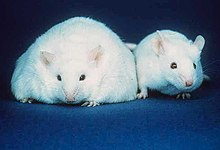ob/ob mouse

The ob/ob or obese mouse is a
leptin, which is important in the control of appetite.The first ob/ob mouse arose by chance in a colony at the
The gene affected by the ob mutation was identified by
A positional cloning approach in the Lepob mouse allows to identify the locus of the gene encoding for the ob protein. Clones were used to construct a contig across most of the 650-kb critical region of ob. Exons from this interval were trapped using exon trapping method and each was afterward sequenced and searched in the GenBank. One of the exons was hybridized to a Northern blot of mouse white adipose tissue (WAT). This allowed to investigate the levels of ob gene expression which seemed to be markedly increased in WAT of Lepob mice. This is consistent with a biologically inactive truncated protein.[3]
